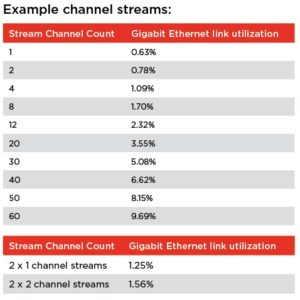As AVB becomes a household name in the professional installed audio industry, there are always lingering questions and confusions that go along with that newness. Here’s 12 of 24 questions and answers about AVB. Look forward to the remaining 12 next month. Let’s dig in:
1) How does AVB fit with other technology like CobraNet® and VoIP?
See diagram below:

2) Why do I need different switches to use AVB?
The most important enabler for AVB technology is the AVB bridge/switch. Unlike current Ethernet switches, AVB switches have additional CPU processing to handle the additional traffic shaping, time synchronization and QoS requirements inherent in AVB-aware networks.
The AVB bridges/switches provide guarantees for time-sensitive, loss-sensitive, real-time AV data transmission while allowing data, audio and video to share the same network. The switches will only allow up to 75% of each network port to be used for AVB traffic.
With AVB, VLANs and separate physical networks are options instead of necessity. The bridge/switch automatically creates a VLAN for AVB traffic, allowing AVB data packets to reach ports with non-AVB aware devices. Therefore, AVB traffic will not pass through non-AVB switches.
3) Can I use AVB with a mixed network?
Yes.
4) What is the latency of AVB?
The latency for AVB is very low. Stream Reservation Protocol (SRP) and the IEEE 802.1Qav Protocol together ensure end-to-end timely delivery of all
reserved media streams. Without these protocols, there is no way to know how much intervening non-media traffic, or how many media packets, the switches may queue up.

With AVB on a wired Ethernet network, the worst-case travel time is known throughout the entire network. As a result, only a small amount of buffering is required and very low latencies – 2ms over 7 switch hops in a 100Mbit Ethernet network – can be achieved, and even better at gigabit speeds.
5) What are the network diameter limitations?
This is variable and dependent upon forwarding delay of the switches used. The network must support a round-trip delay within the AVB latency setting. As Tesira uses Class A latency, this is either 1 or 2ms.
For example, if a switch has a forwarding delay of 150 microseconds (150μs), nine switches will take 1.350ms to move an AVB data stream. Once you then factor in the endpoint processing delay, you are at the 2ms network limit. This sample switch would support 10 switch hops. The use of “faster” switches or uplinks will increase the network diameter. So moving to a 10 Gigabit uplink, or using a switch with a quicker throughput, will mean more switch hops are supported.
6) How will my bandwidth be utilized?
The IEEE 802.1Qat Stream Reservation Protocol (SRP) provides mechanisms for reserving stream bandwidth that allows endpoint applications to configure the routes, eliminating the need for this type of infrastructure network engineering. SRP checks end-to-end bandwidth availability before an AV stream starts. If bandwidth is available, it is “locked down” along the entire path until explicitly released. SRP works hand-in-hand with the IEEE 802.1Qav Queuing and Forwarding Protocol.
Qav schedules time-sensitive AV streaming data, ensuring timeliness through the network. Regular non-streaming traffic is treated in such a way that it cannot interfere with reserved AVB traffic. Utilizing the AVB protocols, intelligent devices communicate with the network to provide reliable AV streaming without the need for the integrator to perform extensive hand-tuning of the network.
7) What layers of technology are available with AVB?
While an IEEE working group has recently ratified AVB for use on Layer 3, it currently only operates as a Layer 2 protocol.
8) What are the product channel capacities?
There are variable stream sizes. Each stream can support between 1-60 channels. Hardware endpoints will dictate the local hardware input or output channel capabilities or requirements.
9) Are media converters available?
AVB bridges/switches are aware of the AVB data packets they are handling and will provide QoS based on the data they are receiving. The switch will be aware of AVB talkers and listeners on the network and any active streams. In order to move AVB data around a network, bridges/switches will need to know how to handle any AVB data. Some media converters act as bridges/switches, which will remove the header information on an AVB stream and, therefore, will act as an AVB boundary. Other media converters act as “true” converters and will forward packets in the same form they are received. These will allow the AVB boundary to be extended to another AVB-aware bridge/switch.
10) How many channels can I send through AVB?
AVB uses the concept of streams and channels. A stream is a connection from one talker to one or more listeners. One stream can be made up of 1-60 channels. Up to 64 streams in and 64 streams out of an (Tesira) AVB interface are supported.

11) What are the bandwidth requirements of AVB?
There are two factors used to calculate AVB bandwidth requirements, which means the calculation is not linear. The first is the stream overhead, which is a fixed requirement and is used to assist in the traffic shaping requirements of the AVB data streams. There is also a calculation for the number of channels of audio the stream contains.

12) What is the resolution and bit-depth of audio through AVB?
This is dependent on the endpoints. Tesira supports 48kHz 24-bit analog-to-digital and digital-to-analog conversion.